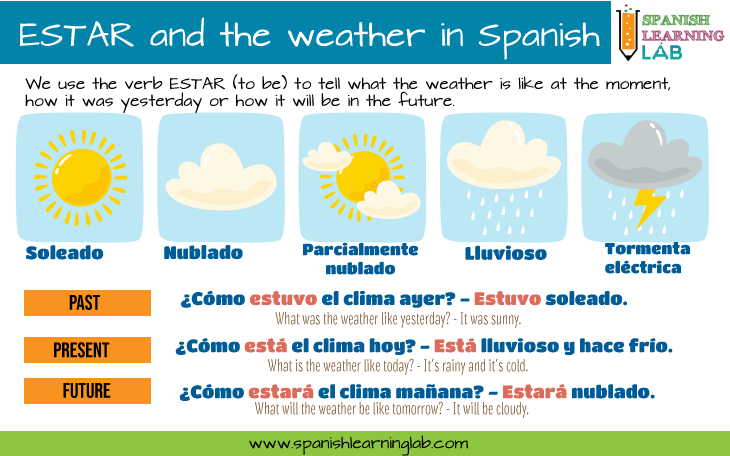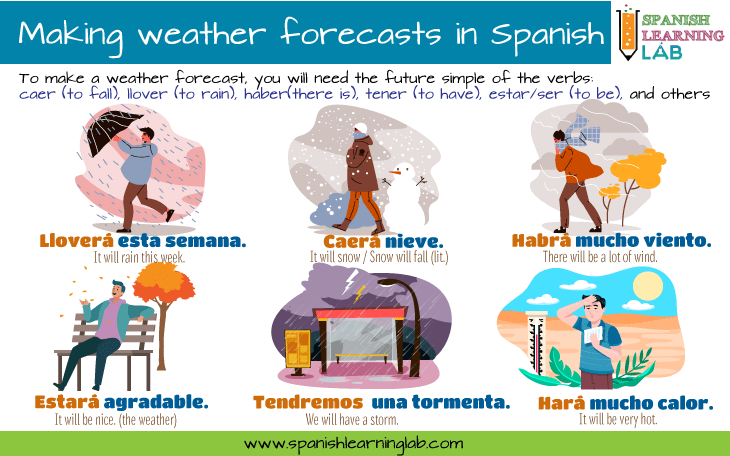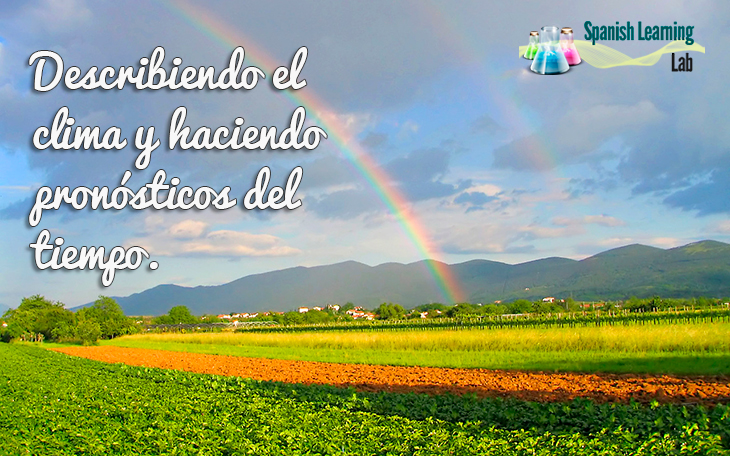Hello and welcome to a new lesson. In the previous lesson, we introduced a list of questions and expressions that are very useful when talking about the weather in Spanish, and we explained how to use the verbs ESTAR, SER, and HABER with this vocabulary. In this lesson, you will find several weather descriptions and forecasts in Spanish, and you can practice with the exercises in various interactive quizzes. Let’s begin…
ESTAR + weather conditions in Spanish
As we mentioned in the previous lesson, you can use several types of verbs and expressions for describing the weather in Spanish at given moment, some of which will be reviewed so that the descriptions provided make sense to you. First, we use both “El clima” and “El tiempo” to refer to the weather. The verb ESTAR is probably the easiest to talk about weather conditions as all we just need to say “El clima está + a weather condition or adjective in Spanish”, being these weather conditions words such as “soleado, nublado, frío, caliente, lluvioso” and so on.

Instead of “El clima” it is possible to use the expression “El día…” or even a season such as “El verano”. Tenses are really important too, especially when it comes to describing the weather in Spanish in the past tense or present tense,not to mention the future tense for a Spanish weather forecast. Check the first example and try to analyze how ESTAR is used for weather descriptions.
Describing the weather in Spanish using ESTAR – Decribiendo el clima
Hoy el clima está muy agradable. Afuera está cálido y soleado, así que puedo salir a comprar algunas cosas y salir a caminar. La temperatura está a 32 grados celcius. No está tan caliente. Ha estado lloviendo en las ultimas semanas. Ayer llovió en la mañana, así que espero que hoy no llueva. Yo creo que el año pasado llovió más que este año.
SER + weather conditions in Spanish
Basically, ESTAR will be used to describe weather conditions that will change regularly, as this verb is normally used to represent states. However, we will use the verb SER to talk about the normal weather in a town or any other place in a given season or time of the year, e.g. “El clima es agradable en esta ciudad” (the weather is nice in this city) or “El clima es muy helado en el invierno” (the weather is very cold in the winter).
It is also possible to explain why a specific weather event or condition is happening using “debido a”, “por” and “porque” as in “El clima es muy agradable la mayoría del tiempo, pero hoy está lloviendo mucho debido al huracán”. This last long sentence explains that the weather is nice most of the time, but it has been raining a lot (using ESTAR not SER) due to a huge storm (una tormenta gigante). Let’s see how both ESTAR and SER are used for describing the weather in Spanish.
Describing the weather in Spanish with SER and ESTAR – Decribiendo el clima
El tiempo es bastante agradable en los países tropicales. Algunas personas piensan que es muy caliente. En la estación seca el clima es bastante caliente en los meses de abril y mayo. Al comenzar la estación lluviosa, las temperaturas bajan un poco. La estación lluviosa es cálida también. A veces el cielo está nublado y a veces está lloviendo mucho debido a los huracanes y tormentas. Diciembre y enero son meses muy fríos.
Writing a weather forecast in Spanish – El pronóstico del clima
In order to make a Spanish weather forecast we must use the future tense. For forecasting, you will need verbs such as “caer” (to fall), “llover” (rain), “continuar” (continue), “ir” (to go), “subir” (go up) and “bajar”(go down), “mover” (to move). The easiest way to transform these verbs in the future tense is by adding either “-A” or “-AN” at the end of the verb, for example:

Present: En este pueblo llueve todos los días (It rains every day in this town)
Future: Lloverá todos los días. (It will rain every day)
Spanish weather forecasts also contain words such as “temperatura”, “lluvia”(rain), “nieve”(snow), “precipitaciones” (precipitation) and many other. Most of the time you will hear a combination of different tenses in order to compare the temperatures from previous days with new ones or to compare other weather conditions. Make sure to add tilde to the last vowel of the verbs in the future when they finish in vowels, e.g. “caerá” when you are writing a description or a weather forecast script. Let’s see all this in an example.
A Script for a Weather Forecast in Spanish – El pronóstico del tiempo
Hoy tendremos un día muy bueno con temperaturas normales que van desde 30 grados en el norte del país hasta 34 en el sur. El cielo estará despejado y no lloverá, a diferencia de los días anteriores. El clima continuará soleado por un par de días más. El fin de semana comenzará a llover de nuevo debido a una tormenta tropical que se desplaza por el oceano Atlántico y llegará al país el viernes por la noche.
Listening Activity No. 1: Talking about the weather in Spanish
Key expressions in the conversation:
- “Por fin“, means “At last”
- “Eso fue lo que escuché…“, means “That’s what I heard”

Listening Activity No. 2: The weather forecast in Spanish
Homework:
Do some research about the weather in your town and write a script for Spanish weather forecast using your own information. Make sure to check the examples in this lesson and use other verbs if necessary. ¡Hasta pronto!
Related Spanish Worksheets:
- The Vocabulary for the Weather in Spanish
- Describing the Weather in Spanish
- Weather conversation cards in Spanish
- My Favorite Season in Spanish (Reading)
- Countries with Tropical Weather (Reading)

i want a weather report on a
states in america
REEEEEEEEEE